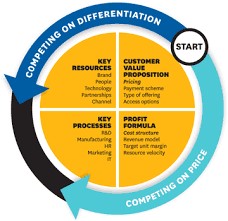Business model innovation is an inescapable necessity. The successful business models which brought us to almost the end of the 20th century are increasingly not valid. This is owed mainly to the exponential rate of change due to technological changes i.e. the 4th industrial revolution. Companies should exhibit courage and consciously put on overhaul their business operations rethinking their practices from A to Z.
The Business Model of a Company determines its life or death.
Any business enterprise is based on a business model i.e. a representation of how an organization makes money. Michael Lewis refers to “business model as a term of art. And like art itself, it’s one of those things many people feel they can recognize when they see it (especially a particularly clever or terrible one) but can’t define”.
What is business model innovation and Why it is so difficult to deliver growth in an existing business model?
As cited in Re-inventing your Business model research has showed that:
- There is a lack of definition owing to the fact that very little formal study has taken place into the dynamics and processes of business model development
- Few companies understand their business model well enough, its interdependencies, its strengths and weaknesses.
As a result, companies do not understand when and how to leverage their core businesses in addition to the fact that their management does not have the time to reflect on those issues, being fixated to the changes in the quarterly results and the corresponding bottom line.
Business Model Innovation demands neither breakthrough technology nor the creation of a brand-new market. It certainly requires more investment in management time, attention and analysis.

Business model innovation questions many of the key decisions and assumptions on the way business operates.
Current practices should come under scrutiny. It is hard but it must be done and it must be done now.
Reappraise your Customer. Are you suitable for him? Is he suitable for you or is he there by force of habit?
Reappraise your procedures, structures and systems. Do they fit the new technological revolution or they are obsolete?
Reappraise your products. Do they have a future?
Reappraise your employees. Are they suitable for the present and the near future? Are their skills and training up to date?
The business model innovation is not the product per se, but all of the dynamic mechanisms which surround the product both before and after sale which together make it more attractive to the final Consumer.
“In the end, the real opportunity may be to shift the focus from technology and product innovation to a different, more powerful, form of innovation: institutional innovation. By rethinking the roles and relationships of large numbers of independent entities, we might be able to generate innovation-driven ecosystems that will change the way we pursue product and technology innovation.”
John Hagel,
(Management consultant, author, speaker, and entrepreneur)
To see past of What Is to What Should Be, Companies need a compass and a map:
- Define clearly the product/service a Customer needs and the role your company will play in getting it done.
- Draft the game plan on how you are going to go about it at a Profit
- Compare this new model to your existing one to assess both the distance and the direction you need to take to accomplish the final objective
- Compare alternative routes to the same final objective i.e. compare your existing business model to alternative ones to identify the most suitable strategy against competitors.
The Constituent Elements of the Business Model and its business implications

Every Company operates according to a business model. The above four elements in the graph form the building blocks of any business. The Customer Value proposition and the Profit formula define the value for the Customer and the Company respectively; while Key Resources and Key Processes describe how this value will be delivered to both the Customer and the Company.
A Business Fitness Test, as the first step to Business Model Innovation, will query the fundamentals on which the current business model is based on, and forgotten in the historic organizational memory. Businesses can easily become hostages of their own success, looking to the past for the keys to their future. Moreover, through our experience at DVK , we have observed that internal bureaucracy, risk of unemployment and future uncertainty tends to preserve the status quo (see also here).
Questions need to be asked as to What kind of decisions are being made and Why.
Business model innovation will unintentionally create internal Company resistance and friction. The status quo should undergo constructive skepticism and tension as opposed to unconstructive conflict. Old assumptions should be reviewed. It needs to be led from the top and encompass the entire organization in a disciplined fashion.
The Business Fitness Test will result in:
- Drastically improving the productivity & efficiency of the current business operations through application of pragmatic solutions, as well as,
- Become the starting point of prioritized action of the top-leadership with regards to, the evolution of the current business model to its future, step-change, iteration, leading to transformation, necessary for the continuation and profitable growth of the business. This will be achieved through a set of, timely implemented action plans, based on a jointly agreed upon roadmap.
Based on our experience at DVK with Business Model Innovation, some key learnings are emerging providing context to an urgent need for action
- Current institutional frameworks/business operating models have worked well in environments of relative stability but have become notable in their lackluster performance in the face of exponential technological changes and changing Customer practices.
- Every company irrespective of its industry should be viewed as a technology company. For instance, many products that once required physical production and distribution can now be produced and distributed electronically etc.
- Companies should be thinking along business ecosystems, platforms where they can leverage learning from every participant including their respective third parties. Learning cannot be limited within the walls of an institution. Which opens a whole new chapter on the profile of the people hired and talent management.
- Companies need infrastructure that supports participant interaction, employees with flexible roles and fluid responsibilities communicating with the same ease inside and outside the organization. An organization ever changing, ever learning ever adapting.
- The starting point of the business transformation starts from top management’s firm recognition that current business structure needs to change. The rest will follow and should encompass the entire organization. It should include, amongst others, a New Vision, firm commitment to an agenda, a Transformation Office to keep the top management in check, track the pace and make sure the internal company mindset is fully aligned, hence there is a joint buy-in; finally, it will require a reallocation and prioritization of investment towards the necessary changes.
- Truly transformative businesses are never about the discovery of a great technology. It is based on a powerful business model. This is exactly what we have observed with Apple, Amazon, Uber etc.
“I think historically where we (venture capitalists) fail is when we back technology. Where we succeed is when we back new business models”

